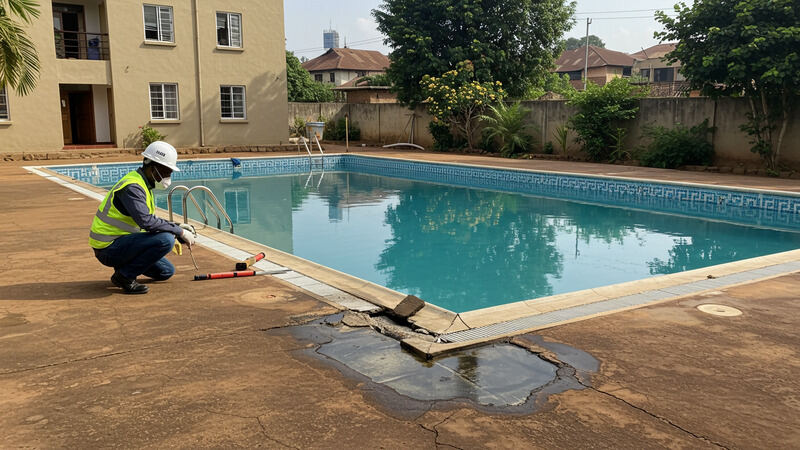Introduction
At You-Swim, we have seen firsthand how early detection and thorough inspection of a leaking swimming pool can prevent extensive structural damage and avoid unnecessary repair costs. Whether you own an inground concrete pool, a vinyl-lined pool, or a custom installation, a systematic inspection of potential leak sources is essential.
This article outlines the critical areas to examine when your pool is losing water, helping you determine whether a leak is present and how to proceed with repairs.
Overview of Pool Leak Issues
Swimming pools are designed to be watertight; however, over time, normal wear and tear, environmental conditions, and shifting foundations can lead to water loss. While evaporation accounts for a predictable decrease in water levels, an unexplained drop beyond expected limits often indicates a leak. By identifying and addressing these issues early, you not only conserve water but also maintain the structural integrity and longevity of your pool.

Key Areas for Inspection for a Leaking Swimming Pool
1. Pool Shell and Structural Components
The pool shell is the primary barrier holding the water. Inspect the following areas:
- Cracks and Fissures: Examine the pool’s concrete or gunite surfaces for hairline or larger cracks. Even minor fissures can expand over time under hydrostatic pressure.
- Plaster or Tile Joints: Look for gaps or separation in the tiling along the waterline. Leaks may originate where the plaster or tiles have deteriorated or where the bond between the tile and substrate has weakened.
2. Plumbing and Piping Connections
A significant portion of pool leaks are associated with the plumbing system that circulates water throughout the facility. Key points to inspect include:
- Return and Skimmer Lines: Check the joints and connectors for signs of water seepage. In inground pools, underground piping can develop cracks due to soil movement, which might be noticeable by localized damp spots on the surrounding deck or landscaping.
- Equipment Pad Area: Examine the area around the pool’s pump, filter, heater, and other mechanical components. Moisture or corrosion on fittings, O-rings, or valves may indicate a leak in the plumbing lines. In some cases, performing a simple bucket test (comparing water loss from a bucket placed in the pool versus the surrounding water level) can help determine whether the loss is due to evaporation or an actual leak.
3. Seals, Gaskets, and Fittings
Leaks can also occur at the interfaces between different pool components:
- Skimmer and Light Fittings: Inspect the seals around skimmers, lights, and other protruding fixtures. Over time, seals can deteriorate or become dislodged, allowing water to escape through small gaps.
- Bonding Points: Check all connection points where dissimilar materials meet. For example, the interface between a vinyl liner and the pool coping or between a concrete shell and plastic components should be examined for any sign of separation or wear.
4. Vinyl Liners and Surface Coverings
For pools with vinyl liners, inspect the following:
- Tears or Punctures: Carefully examine the liner for any cuts, abrasions, or punctures that could cause a leak.
- Seam Integrity: If your pool has a custom liner, the seams are critical areas. Ensure that all seams are properly adhered to and free from gaps where water could seep through.

Why do you need Professional Swimming Pool Repair Services?
We understand that pinpointing the exact source of a leaking swimming pool can be challenging, even with a systematic inspection. Our experienced professionals use advanced diagnostic tools and techniques to accurately locate the problem areas. Once identified, our repair solutions are designed to provide durable, cost-effective results that restore your pool’s integrity and functionality.
Next Steps
A leaking swimming pool is more than just an inconvenience; it can lead to escalating water bills, structural damage, and costly repairs if not addressed promptly. By methodically inspecting the pool shell, plumbing connections, seals, and liner, you can often determine the source of the leak early. However, for comprehensive diagnostics and repair, the expertise of a dedicated pool repair professional is invaluable.
For a thorough inspection and expert repair service, please visit our page here for more information.
Frequently Asked Questions: Leaking Swimming Pool Repair
1. How do I know if my swimming pool is leaking?
Look for signs like a sudden drop in water level, constantly running auto-fill systems, damp spots around the pool, and unusually high water bills. You can also perform a bucket test to check if water loss is due to evaporation or a leak.
2. How to tell if a pool is leaking or evaporating?
Place a bucket filled with water on a pool step and mark the water levels inside and outside the bucket. After 24 hours, if the pool water drops more than the bucket water, you likely have a leak. Evaporation affects both levels equally.
3. What are the most common causes of pool leaks?
Leaks often occur in the pool shell, skimmer, return lines, main drain, light fittings, or underground plumbing. Ageing materials, ground shifts, or tree roots can also cause leaks.
4. Where is the most common place for a pool leak?
Leaks typically happen in the skimmer, pool shell cracks, return fittings, underground pipes, or equipment like the pump and filter.
5. Where does water go when a pool leaks?
Water from a leaking pool usually seeps into the ground, affecting soil stability and nearby structures. If the leak is in the plumbing, water may flow underground, causing wet spots or sinkholes.
6. Can you fix a pool leak without draining?
Yes, minor leaks can often be sealed underwater using special epoxy or sealants. However, severe leaks in the plumbing or shell may require partial or complete draining for proper repair.
7. Can I fix a pool leak myself?
Small leaks, such as those in fittings or minor cracks, can sometimes be patched using waterproof sealants. However, underground or structural leaks require professional repair.
8. How much does it cost to repair a leaking swimming pool?
Costs vary based on the leak’s location and severity. Minor repairs may cost a few thousand shillings, while major plumbing or structural repairs can be more expensive.
9. How long does pool leak repair take?
Simple repairs may take a few hours, while extensive plumbing or resurfacing work could take days or weeks.
10. Can I use my pool while it’s leaking?
It depends on the severity. Small leaks may not affect usage immediately, but larger leaks can cause structural damage. It’s best to fix leaks promptly to avoid costly repairs.
11. How do professionals detect pool leaks?
Experts use dye tests, pressure tests, and specialized listening devices to find leaks. Some advanced methods include thermal imaging and injecting polyurethane grout behind the shell to seal leaks.
12. How can I prevent pool leaks in the future?
Regular maintenance is key. Inspect your pool shell, plumbing, and equipment frequently, keep the water chemistry balanced, and address small cracks or issues before they worsen.


